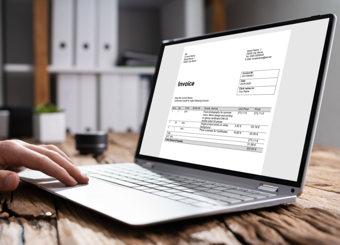What is eInvoicing, and why does your business need it?
According to our research with over 200 Finance professionals, nearly 45% of invoices are still delivered via manual channels. It’s little surprise then that the most common digital transformation objective among finance professionals is the acceleration and improvement of manual processes, cited by 85% – and this is where eInvoicing, also known as electronic invoicing, comes into place.
In this article, we will cover what is eInvoicing – including its role in the Finance and Accounts Payable team, and the features and functionality of an invoicing system. We’ll explore the pros and cons of implementing an eInvoicing system, and also tips on how to achieve 100% electronic invoicing in order to maximise your investment, to cut costs and boost your operational efficiency.
So, what is eInvoicing?
In a nutshell, eInvoicing is a business to business practice that refers to the exchange of invoice documents between businesses and the automation of invoicing processing. It eliminates paper invoices and the associated error-prone, inefficient manual tasks such as manually re-keying data from the invoice into the buying organisation’s purchasing or finance system.
The true meaning of eInvoicing involves retrieving data from the suppliers invoices, in a format that goes into the Finance system directly without any data input activity. Therefore, receiving a PDF and keying into the system doesn’t count as a true e-invoice, nor does OCR scanning of a paper invoice.
Why organisations use eInvoicing
Processing invoices manually is extremely time consuming, labour intensive and prone to error and query. Without the right technology, it’s not uncommon to see invoices rolling in with incorrect coding, missing VAT or PO numbers, which can delay the processing process and have a huge knock on effect on your supply chain. When payment is constantly delayed, suppliers are not going to be happy, which can exhaust your credit lines and good will, result in a knock-on effect on your production schedules, delaying your orders and ultimately leading to unhappy customers.
According to our research, an organisation usually reaches its tipping point when it starts processing over 500 invoices per month, pushing them into moving over to electronic invoicing.
Pros and Cons of eInvoicing
There are many obvious benefits for implementing eInvoicing. To start with, by automating the process you are dramatically reducing overhead costs, improving productivity and efficiency and meeting your green initiatives by cutting out paper and printing. And because you’re always paying your suppliers on time and using a more streamlined, transparent process, expect improvement in your supplier relationship (discounts even!) and more accurate working capital positions.
eInvoicing also has many benefits for individual stakeholders:
For the Finance team, and especially the Accounts Payable team, an improvement in processing accuracy allows them to process payment much more quickly and reduce the number of disputes and exceptions so they can focus on higher value activities. According to our research, invoice handling is actually the most hated job aspect within the finance department. So by eliminating manual processing, you should see an improvement in work morale and a more motivated team.
The management team can, on the other hand, enjoy improved spend visibility, compliance and better optimised working capital. As for suppliers, because they’re getting paid faster and having fewer rejected invoices, they’ll enjoy a more productive relationship, quicker accounts reconciliation and improved cash management too.
On the flip side, implementing an eInvoicing solution can involve quite a few different parties of your business, so you need to make sure you have the knowledge and resources to carry out the project. Also suppliers may not want to change the way they work with you, and given that a new system will only work if suppliers are happy to compromise and collaborate with you, you really need to plan ahead with them to ensure a high adoption rate.
How it works
Suppliers send invoices via many different ways, and that’s why we use electronic invoicing software to make sure everything can be processed digitally, with as little manual intervention as possible.

A good starting point would be to segment suppliers into three tiers based on criteria such as level of trade with them and importance to your organisation. Top tiers suppliers can be mandated to establish a direct integration with your systems which means a completely touchless process for you to speed up your entire invoice cycle. Alternatively, mid-tier suppliers can key in or upload invoices directly via a dedicated portal using pre-set templates. For smaller suppliers, they can email you the invoice as an attachment, through which the eInvoicing software can automatically extract the information and transfer it into your finance system.
At this point you probably won’t be surprised to hear that we have a system called Medius AP Automation which does all these. If you want to know more about it you can download our Medius AP Automation product guide here.






